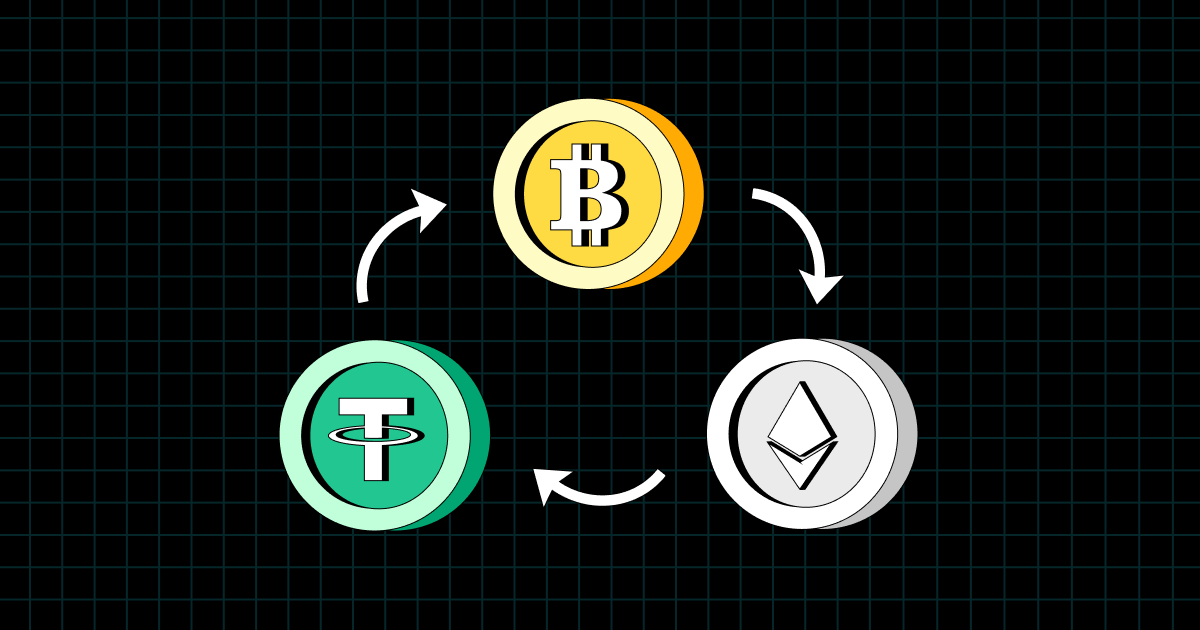In the world of digital assets, not only forecasts and technical analysis are important. Sometimes profit is born from discrepancies. One of such tools is valuation speculation. It allows you to earn not on the rise or fall of the price, but on the difference in exchange rates between currency pairs within one exchange. To understand what triangular arbitrage is, it is necessary to understand the logic of calculation and the sequence of actions.
Principle of operation: how the opportunity for profit arises
Currencies on exchanges are traded in pairs: BTC/USDT, ETH/BTC, ETH/USDT, and so on. When there is a discrepancy in rates between three such pairs, there is a chance to make a circular deal and profit without market risk.

How triangular arbitrage works: a trader starts with one currency (for example, USDT), exchanges it for a second (for example, BTC), then for a third (for example, ETH), and finally returns to the initial currency (USDT). If the final amount exceeds the starting one, the cycle is successful.
Success depends on speed, liquidity, accuracy of calculation, and commission level. With the right configuration, the system allows you to profit even from minimal price divergences.
What is triangular cryptocurrency arbitrage in simple terms
In simple terms, a closed arbitrage cycle is a series of three exchanges in which currencies are exchanged for each other within one platform to take advantage of discrepancies in quotes.
Unlike inter-exchange trading, this method requires only one account and is not dependent on the speed of transfer between platforms. The main factor is instant order execution and accurate analysis of each pair’s exchange rate.
What is triangular arbitrage? It is a scheme where the transaction goes through a chain: currency A → currency B → currency C → back to currency A. The goal is to close the loop with a profit. If positive divergences are formed at each point in the cycle, a clear opportunity for profit arises – regardless of the overall market direction.
Example of triangular arbitrage: how a deal looks in reality
Let’s say a trader starts with 1000 USDT. The market situation is as follows: the BTC/USDT rate is 50,000, ETH/BTC is 0.06, and ETH/USDT is 3100.
He exchanges 1000 USDT for 0.02 BTC at the current rate, then converts 0.02 BTC into 0.333 ETH through the ETH/BTC market.
The final step is selling 0.333 ETH for 3100 USDT, bringing in 1032.30 USDT. As a result, a profit of 32.30 USDT for one trading cycle.
Such earnings become possible with triangular arbitrage. However, these opportunities last for seconds, and without automated algorithms, capturing them is practically impossible.
Conditions affecting the success of inter-exchange operations
At first glance, the tactic may seem foolproof. However, for it to work effectively, it is important to understand what triangular arbitrage is and consider a whole range of technical and market parameters. Only a comprehensive approach allows extracting real profit from the strategy.
A list of factors directly affecting the result:
- order execution speed: every millisecond affects the outcome;
- exchange commission: it is important that the fee amount does not exceed the profit size;
- sufficient liquidity: orders must be executed at the desired price;
- accuracy of calculation: any rounding can change the result;
- minimization of slippage: especially relevant for large volumes.
Even with perfect calculation, unnecessary delays or spread increases can turn profit into a loss. Therefore, arbitrage trading requires discipline, automation, and a deep understanding of exchange mechanics.
How to correctly use trading on price imbalances?
A successful trader does not rely on chance. They build a system where every step is calculated. That is why it is important to understand what triangular arbitrage is and include it as part of the overall scheme, rather than using it as a one-time attempt to make a quick profit. Only a systematic approach allows consistently extracting profit from short-term market inefficiencies.
It is important to conduct a deep analysis of the selected platform, study the available pairs, assess the stability of quotes. The next step is to connect a bot or script capable of instantly identifying opportunities and executing a trade. Manual work is practically impossible due to narrow time windows.
It is also important to regularly review settings: the market changes, volatility increases, algorithms require optimization. Without adaptation, even a good strategy loses profitability.
Where to apply the tactic: features of different exchanges
Not every exchange is suitable for trading. Conditions may vary in terms of delays, commissions, order book depth, technical stability. Some platforms prohibit arbitrage or restrict the activity of trading bots.
It is better to choose platforms with high liquidity, a large number of pairs, low commissions, and unrestricted API access. These conditions allow running trading algorithms without the risk of account blocking.
Advantages and limitations of the method
Like any trading tool, valuation speculation has both strengths and weaknesses. Its key advantage is the ability to profit without the need to predict market direction. This is especially relevant if you understand what triangular arbitrage is.
The strategy remains effective regardless of whether the price rises or falls, and with proper implementation, the risk is minimal. Playing on exchange rate differences allows for quick entry into a trade, fixing the result, and applying it both in manual trading and through trading bots.
However, there are limitations. The scheme requires high technical preparation and quick reaction, especially in conditions where opportunities arise and disappear in seconds.
Often automation is necessary, which means programming skills or access to ready-made solutions. With low liquidity or high commissions, cyclic exchange loses efficiency, and delays can reduce profit to zero.
Understanding the factors helps form a realistic approach and use arbitrage not as a magic button but as a precise tool within a reasonable strategy.
Conclusions
Understanding what triangular arbitrage is opens access to one of the most sophisticated methods of earning in the crypto market. It is not a universal recipe for wealth but a mathematically refined model built on the imperfections of the trading system.

A trader who masters such a tactic gains a flexible and potentially profitable mechanism that can deliver results regardless of volatility. The key is precise calculation, automation, and cost control.
Trading on price imbalances is a tactic where the winner is not the one who takes the most risk but the one who acts more accurately and faster.
 en
en  ru
ru  de
de  ar
ar  es
es  nl
nl  hi
hi  fr
fr  it
it  pt
pt  el
el 











